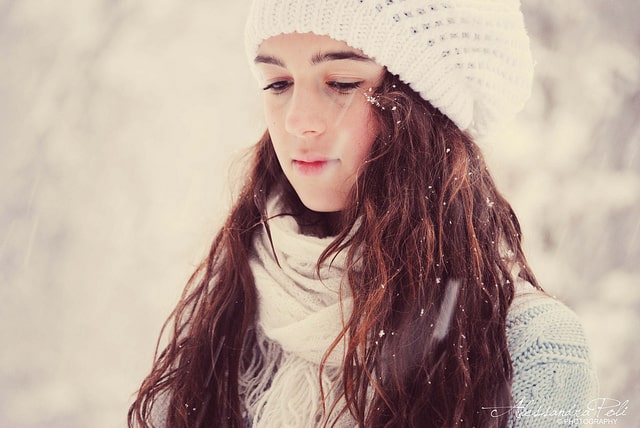Don’t let the cold weather leave your hair dry, limp, and thirsty!
Plummeting temperatures, blustery winds, and icy snowstorms are harsh conditions that make it difficult to maintain lustrous hair. While staying cozily warm indoors—whether by a fire or nestled in a ski lodge—offers respite from cold ambient temperatures, the extreme heat damages hair similar to that caused by heat-styling tools.
But don’t fret! Even if the conditions inside are just as harmful to your hair as those outside, there are easy, actionable steps you can take to protect your locks for radiant hair throughout the winter months.
Follow these steps to care for your hair both internally and externally, and achieve lustrous, bouncy, healthy winter hair.

Internal Conditions
What you eat nourishes your hair. Strive to consume nutrient-rich foods for hair strength, growth, and shine.
1. Omega-3 fatty acids
Omega-3 fatty acids assist in hair growth, natural oil production for maintaining hydration, and healthy cell membranes in scalp skin. Some of the best sources are found in wild salmon, sardines, and walnuts.
Related: 5 Minimalist Workouts For Rapid Fat Loss
2. Zinc
This is an important mineral for preventing hair loss and dandruff. Get your daily dose of zinc by eating oysters, beef, pumpkin seeds, and eggs.
3. Biotin
This is a B complex vitamin that prevents thinning hair and breakage due to dryness. Achieve the recommended daily dose by consuming eggs, Swiss chard, carrots, halibut, and nuts.
4. Iron
Anemia—a condition in which your body doesn’t have enough iron—leads to hair loss. And iron helps oxygenate hair follicles for nourished locks.
Related: 5 Secrets Nutritionists And Fitness Experts Haven’t Told You
The best sources of iron include animal meats, but you can also obtain it from eggs and vegetables. However, our bodies are less efficient at absorbing iron from plant-based sources. To enhance absorption, pair an iron-rich food source with vitamin C.
5. Vitamin C
This important vitamin heightens blood flow to the scalp and nourishes blood vessels for healthy hair follicles. Maintaining optimal Vitamin C levels prevents hair breakage and split ends.
Some of the best sources of Vitamin C include blueberries, camu camu, papaya, bell peppers, broccoli, and Brussels sprouts.
6. Vitamin E
This is an antioxidant that protects against sun damage, promotes healthy hair growth, and strengthens hair by assisting with your body’s production of keratin within hair strands.
Related: The Benefits Of Vitamin D: Why You Need More Sun
Make sure you include foods rich in Vitamin E, such as leafy greens, almonds, sunflower seeds, and olives to get luxurious winter hair.
7. Protein
Your hair is mostly composed of protein, and protein is involved in cell growth and repair. Therefore, consuming enough protein ensures that your body can replace the hair that it naturally loses each day, and keeps hair strong and hydrated rather than weak, brittle, or dry.
Rich sources of protein include fish, poultry, beef, nuts, seeds, eggs, beans, and legumes.
External Conditions
How you care for your hair translates to whether or not you support hydrated, strong, lustrous hair. Develop a hair care routine that delivers nutrients to your hair and shields it from harmful weather conditions, and achieve locks you love!
1. Scalp massage
Massaging your scalp increases blood flow to the area, which helps promote hair growth and produces natural oils to condition hair. It also prevents dandruff by exfoliating the skin and allowing the scalp and hair to be conditioned by natural oils.
2. Brush correctly
Brushing your hair from the base of your neck to the ends while bending over with knees slightly bent will also enhance blood flow to your scalp and release natural oils to stimulate growth and conditioning. My favorite brush is made of boar bristles. Always be gentle when brushing your hair to avoid breakage.
3. Harness the power of essential oils
Rosemary essential oil is particularly powerful for increasing circulation to the scalp. Add a few drops to your shampoo or massage oil and rub into your scalp to stimulate hair growth and deliver nutrients to hair follicles.
Related: Essential Oils Demystified, Once And For All: Separating Fact From Fiction
4. Condition
Applying a deep conditioner enables the hair to retain moisture and offers a protective barrier against the dry winds of winter. Depending on your hair type, you might apply a deep conditioner on a weekly or monthly basis throughout the winter season.
My favorite is one composed of multiple oils such as jojoba, macadamia nut, walnut, and avocado oils. Conditioning treatments range from 20-minute leave-ins to overnight applications, so find what works best for you.
Always follow shampooing your hair with a hydrating conditioner rinse. Conditioning your hair will infuse it with hydration; thereby, minimizing or eliminating the typical static cling that results when dry hair attracts electrical charge.
5. Accessorize
Physically protect your hair from dry, cold air with a hat, scarf, or hood. This will not only keep your head warm and increase blood flow to your scalp, but it will prevent your hair from losing moisture.
Related: Winter Is Coming: 6 Ways To Stay Healthy During The Cold Weather
Ladies may even wish to style their hair in buns, braids, or ponytails to decrease the surface area of the hair that is exposed to the cold air.
6. Avoid heat extremes
While a steaming hot shower might warm you up, excessively hot water will contribute to drying out hair.
Opt for tepid water to rinse your locks instead. You might even want to finish your shower with a cool rinse.
If possible, you should also avoid or limit your use of heat-styling tools. These dry out hair and can worsen damage to your hair caused by winter weather. If you style your hair with heat tools such as a blow dryer, be sure to apply a light leave-in conditioner prior to heat application for further protection.
The Takeaway
With a little forethought and attention to how you care for your body inside and out, achieving lustrous, winter healthy hair throughout the cold months is incredibly easy. A multi-pronged approach to winter hair care encompasses eating wholesome foods and applying physical protection to your hair. Put some bounce and shine into the winter months with hair that reflects a vitally vibrant you!
***********************
 Christine Cherpak is a health coach and yoga teacher who nourishes the human spirit and celebrates the rhythms of life. Freeing herself of food allergy restraints and claiming her true self, Christine empowers others to achieve a balanced state while learning to live, play, and love food again. Learn more about Christine by visiting Kalena Spire and Pinterest.
Christine Cherpak is a health coach and yoga teacher who nourishes the human spirit and celebrates the rhythms of life. Freeing herself of food allergy restraints and claiming her true self, Christine empowers others to achieve a balanced state while learning to live, play, and love food again. Learn more about Christine by visiting Kalena Spire and Pinterest.
Photo by Alessandra Poli
